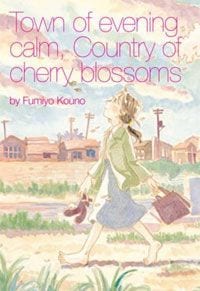
For better or worse, until recently there has only been one internationally prominent Japanese manga about the nuclear bombing of Japan. One possible reason for this is that any new works would have a tough act to follow: Keiji Nakazawa, a Hiroshima survivor, drew from his personal experience to create remarkable “ground zero” accounts of the bomb in I Saw It and Barefoot Gen. The latter has become one of the most widely recognized manga ever written, and was one of the first to be translated into English. Yet even if someone wanted to follow such a work, one lingering question remains: can such a unique and catastrophic experience truly be understood by someone who wasn’t there, and is it presumptuous to try?
Artist Fumiyo Kouno cites the latter feeling while explaining her initial reluctance to write her own story about the Hiroshima bombing. These reservations strongly influenced her approach; rather than follow Nakazawa’s lead, she instead chose to explore the long-term effects the bomb had on its victims and their children. To that end, she presents two stories in this short anthology: Town of Evening Calm follows the experience of 23-year-old Minami Hirano, who survived the blast as a young teen, and the two-part Country of Cherry Blossoms features Nanami Ishikawa, Hirano’s niece, as she grapples with how the bomb has affected her family as a child and an adult.
Although there is a sense of distance between these stories and the event that inspired them, the work is arguably better for it. While eyewitness accounts of such a disaster are certainly effective for raising awareness and provoking emotional reactions, the sheer magnitude of these events makes them very difficult to fully comprehend. By framing the bomb in a less spectacular context, Kouno makes a very difficult subject a little easier for most of us to relate to.
This distance does little to reduce the gravity of the consequences: years and even decades after the bombing, people have continued to die of radiation poisoning and cancer in a frighteningly arbitrary pattern. Those associated with the bombing face discrimination, for they’ve been “contaminated” with radiation. These incidents are certainly less dramatic to read about than collapsing buildings and melting flesh, but this personal approach helps transform what many people view as a one-time historical event into something with enduring and terrifying consequences.
Despite the weight of this message, Kouno carefully avoids overplaying her hand in its presentation. While not utterly devoid of pathos or sentimentality, these stories present themselves in a disarmingly matter-of-fact manner. They confront the cold determinism of the bombing’s aftermath without becoming unbearable exercises in self-pity and despair. The opposite, in fact, is true. Even in the anthology’s darkest moment, hope is echoed in Minami’s words: “No matter how many times the [evening calm] fades, this story won’t ever end”. This defiant statement comes full circle in Country of Cherry Blossoms, when Nanami refuses to let the bomb’s influence tear yet another relationship apart. While relatively small, the gesture she makes is a moving affirmation of the hope Minami expressed.
It’s a fitting conclusion, because hope is very close to the heart of this anthology’s morality. As easy as it would have been to use pessimism and blame to stir up antiwar sentiments, the story instead appeals to compassion and common humanity. It asks us to remember that war has personal and societal consequences that endure well beyond the political or financial, and the innocent often suffer as much as the guilty. It encourages us to remember and learn from the past. It takes a certain measure of hope to do these things, but Kouno’s is not naïve or overly idealistic. She offers no courses of action or expectations of success, just a simple manifesto: “we are human, all of us”.
Some may dismiss such a thought as useless truism, but it remains relevant given the wartime practice of demonizing the enemy. In World War II, the American government and media went to extremes in dehumanizing the Japanese, which some argue may have helped lead to the decision to use such a horrifying weapon. A similar situation has plagued the current War on Terror, where the boundaries of torture have been crossed in the name of fighting the enemy. Just as innocent Japanese-Americans were unjustly rounded up into internment camps, many peaceful Muslims have found themselves on the receiving end of suspicion, hate speech, and discrimination. In light of all this, Kouno’s plea for understanding takes on a particularly haunting, urgent resonance.

![Call for Papers: All Things Reconsidered [MUSIC] May-August 2024](https://www.popmatters.com/wp-content/uploads/2024/04/all-things-reconsidered-call-music-may-2024-720x380.jpg)



